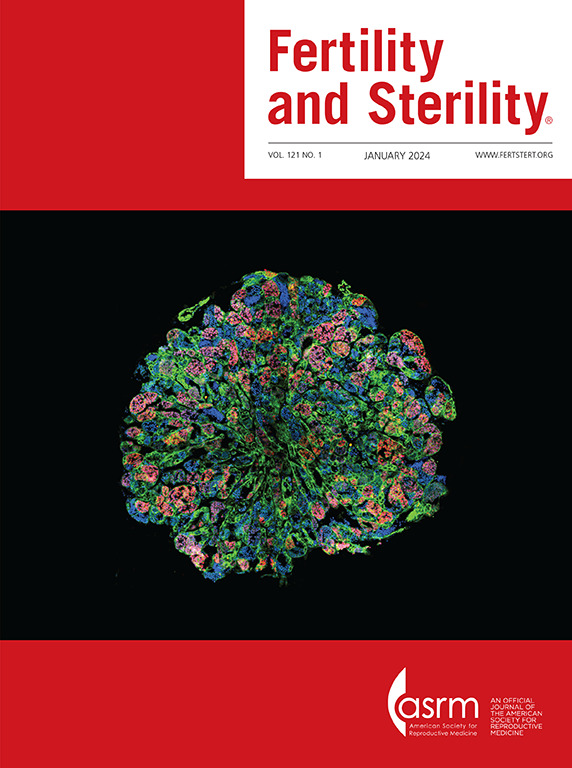Pregnancy complications and birth outcomes in women with polycystic ovary syndrome undergoing frozen embryo transfer
IF 6.6
1区 医学
Q1 OBSTETRICS & GYNECOLOGY
引用次数: 0
Abstract
Objective
To determine whether polycystic ovary syndrome (PCOS) increases adverse pregnancy and birth outcomes in women undergoing frozen embryo transfer (FET).
Design
Retrospective cohort study. The PCOS group was matched 1:2 with the control group population using propensity score matching.
Setting
Not applicable.
Patient(s)
During an 8-year period, 2,955 patients aged 20–40 years who underwent FET and delivered between January 2015 and December 2022 at the Reproductive Medical Center of Ruijin Hospital were evaluated for adverse pregnancy outcomes.
Intervention(s)
None.
Main Outcome Measure(s)
All patients were assessed for specific pregnancy complications and birth outcomes, with a sub-group analysis conducted to compare patients with PCOS with and without hyperandrogenism.
Results
Women with PCOS demonstrated higher rates of gestational diabetes mellitus (24.9% vs. 16.4%; relative risk [RR], 1.51; 95% confidence interval [CI], 1.26–1.82; P<.001), gestational hypertension (12.2% vs. 8.9%; RR, 1.37; 95% CI, 1.05–1.80; P=.022), preterm prelabor rupture of membranes (7.0% vs. 3.6%; RR, 1.92; 95% CI, 1.29–2.86; P=.001), cervical length shortening (1.8% vs. 0.4%; RR, 8.39; 95% CI, 1.56–12.49; P=.002), large-for-gestational age (17.4% vs. 13.7%; RR, 1.27; 95% CI, 1.02–1.57; P=.032), and low birth weight (19.9% vs. 16.0%; RR, 1.25; 95% CI, 1.02–1.52; P=.030) in overall propensity score matching analysis. Newborns of patients with PCOS had a higher risk of preterm birth <37 weeks (10.5% vs. 6.6%; RR, 1.59; 95% CI, 1.12–2.26; P=.009) in singleton pregnancies. Patients with PCOS with hyperandrogenism showed a higher incidence of cervical length shortening (5.5% vs. 0.5%; adjusted odds ratio, 15.62; 95% CI, 2.25–108.48; P=.005) compared with those without, after adjusting for relevant confounders.
Conclusion(s)
Polycystic ovary syndrome increases the incidence of adverse pregnancy outcomes after FET cycles. Our study suggests women with PCOS may warrant further monitoring and additional counseling before and during pregnancy.
Complicaciones del embarazo y parto en mujeres con Síndrome de ovario poliquistico sometidas a transferencia de embriones congelados.
Objetivo
Determinar si el síndrome de ovario poliquístico (SOP) aumenta los resultados adversos del embarazo y del parto en mujeres sometidas a transferencia de embriones congelados (FET).
Diseño
Estudio de cohorte retrospectivo. El grupo con SOP se emparejó 1:2 con la población del grupo de control usando el método de emparejamiento de propensión.
Entorno
No aplicable.
Paciente(s)
Durante un período de 8 años, 2955 pacientes de entre 20 y 40 años que se sometieron a FET y dieron a luz entre enero de 2015 y Diciembre de 2022 en el Centro Médico Reproductivo del Hospital Ruijin fueron evaluados para detectar resultados adversos del embarazo.
Intervención(es)
Ninguna.
Principales medidas de resultado
Todas las pacientes fueron evaluadas para detectar complicaciones específicas del embarazo y resultados del parto, con un análisis de subgrupo realizado para comparar pacientes con SOP con y sin hiperandrogenismo.
Resultados
Las mujeres con síndrome de ovario poliquístico demostraron tasas más altas de diabetes mellitus gestacional (24,9 % frente a 16,4 %; riesgo relativo [RR], 1,51; 95 % intervalo de confianza [IC], 1,26–1,82; P<0,001), hipertensión gestacional (12,2% vs. 8,9%; RR, 1,37; IC 95%, 1,05–1,80; P=0,022), rotura prematura de membranas antes del parto (7,0 % frente a 3,6 %; RR, 1,92; IC del 95 %, 1,29–2,86; P = 0,001), acortamiento de la longitud cervical (1,8 % frente a 0,4 %; RR,8,39; IC del 95 %, 1,56–12,49; P = 0,002), grande para la edad gestacional (17,4 % frente a 13,7 %; RR, 1,27; IC del 95 %, 1,02–1,57; P = 0,032) y bajo peso al nacer (19,9% vs. 16,0%; RR, 1,25; IC 95%, 1,02–1,52; P = 0,030) en el análisis usando el indice de propensión general. Recién nacidos de pacientes con síndrome de ovario poliquístico tuvieron un mayor riesgo de parto prematuro <37 semanas (10,5 % frente a 6,6 %; RR, 1,59; IC 95 %, 1,12–2,26; P = 0,009) en pacientes con embarazos unico. Los pacientes con síndrome de ovario poliquístico con hiperandrogenismo mostraron una mayor incidencia de acortamiento de la longitud cervical (5,5 % frente a 0,5 %; odds ratio ajustado, 15,62; IC del 95 %, 2,25–108,48; P=0,005) en comparación con aquellos que no lo tenían, después de ajustar por factores de confusión relevantes.
Conclusión(es)
El síndrome ovario poliquístico aumenta la incidencia de resultados adversos en el embarazo después de ciclos FET. Nuestro estudio sugiere que las mujeres con síndrome de ovario poliquístico pueden requerir mayor seguimiento y asesoramiento adicional antes y durante el embarazo.
接受冷冻胚胎移植的多囊卵巢综合征妇女的妊娠并发症和分娩结局。
目的确定多囊卵巢综合征(PCOS)是否会增加接受冷冻胚胎移植(FET)妇女的不良妊娠和分娩结局:设计:回顾性队列研究。采用倾向得分匹配法(PSM)将多囊卵巢综合征组与对照组人群进行1:2匹配:对瑞金医院生殖医学中心2015年1月至2022年12月期间接受FET并分娩的2955名20至40岁患者进行不良妊娠结局评估:无:对所有患者的具体妊娠并发症和分娩结局进行评估,并进行亚组分析,比较多囊卵巢综合征患者有无高雄激素症:结果:患有多囊卵巢综合征的女性妊娠糖尿病发病率更高(24.9% 对 16.4%;相对风险 (RR) 1.51 [95% 置信区间 (CI):1.26-1.82];P 结论:多囊卵巢综合征会增加不良妊娠并发症的发病率:多囊卵巢综合征会增加 FET 周期后不良妊娠结局的发生率。我们的研究表明,患有多囊卵巢综合症的妇女可能需要在怀孕前和怀孕期间接受进一步的监测和额外的咨询。
本文章由计算机程序翻译,如有差异,请以英文原文为准。
求助全文
约1分钟内获得全文
求助全文
来源期刊

Fertility and sterility
医学-妇产科学
CiteScore
11.30
自引率
6.00%
发文量
1446
审稿时长
31 days
期刊介绍:
Fertility and Sterility® is an international journal for obstetricians, gynecologists, reproductive endocrinologists, urologists, basic scientists and others who treat and investigate problems of infertility and human reproductive disorders. The journal publishes juried original scientific articles in clinical and laboratory research relevant to reproductive endocrinology, urology, andrology, physiology, immunology, genetics, contraception, and menopause. Fertility and Sterility® encourages and supports meaningful basic and clinical research, and facilitates and promotes excellence in professional education, in the field of reproductive medicine.
 求助内容:
求助内容: 应助结果提醒方式:
应助结果提醒方式:


